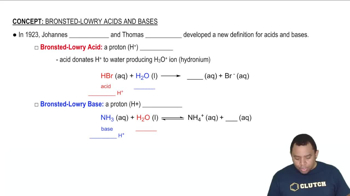Write balanced molecular and net ionic equations for the following reactions, and identify the gas formed in each: (a) solid cadmium sulfide reacts with an aqueous solution of sulfuric acid (b) solid magnesium carbonate reacts with an aqueous solution of perchloric acid.
Ch.4 - Reactions in Aqueous Solution
Chapter 4, Problem 44
As K2O dissolves in water, the oxide ion reacts with water molecules to form hydroxide ions. (a) Write the molecular and net ionic equations for this reaction. (b) Based on the definitions of acid and base, what ion is the base in this reaction? (c) What is the acid in the reaction? (d) What is the spectator ion in the reaction?
 Verified step by step guidance
Verified step by step guidance1
Step 1: Write the molecular equation for the dissolution of K2O in water. Potassium oxide (K2O) reacts with water (H2O) to form potassium hydroxide (KOH). The molecular equation is: K2O(s) + H2O(l) → 2 KOH(aq).
Step 2: Write the net ionic equation. Since KOH is a strong base, it dissociates completely in water into K+ and OH- ions. The oxide ion (O2-) from K2O reacts with water to form hydroxide ions (OH-). The net ionic equation is: O2-(aq) + H2O(l) → 2 OH-(aq).
Step 3: Identify the base in the reaction. According to the Brønsted-Lowry definition, a base is a substance that accepts protons (H+). In this reaction, the oxide ion (O2-) accepts protons from water to form hydroxide ions, making O2- the base.
Step 4: Identify the acid in the reaction. An acid is a substance that donates protons (H+). In this reaction, water (H2O) donates protons to the oxide ion to form hydroxide ions, making H2O the acid.
Step 5: Determine the spectator ion. Spectator ions are ions that do not participate in the chemical reaction. In the dissolution of K2O, the potassium ion (K+) does not participate in the formation of hydroxide ions and remains unchanged in the solution, making K+ the spectator ion.
Key Concepts
Here are the essential concepts you must grasp in order to answer the question correctly.
Dissociation and Ion Formation
When ionic compounds like K2O dissolve in water, they dissociate into their constituent ions. In this case, K2O breaks down into potassium ions (K+) and oxide ions (O2-). The oxide ions then react with water to form hydroxide ions (OH-), illustrating the process of ion formation in aqueous solutions.
Recommended video:
Guided course

Ion Formation
Acid-Base Theory
According to the Brønsted-Lowry acid-base theory, an acid is a substance that donates protons (H+), while a base is a substance that accepts protons. In the reaction involving K2O, the oxide ion acts as a base by accepting protons from water, leading to the formation of hydroxide ions, which are characteristic of basic solutions.
Recommended video:
Guided course

Bronsted-Lowry Acid-Base Theory
Net Ionic Equations
Net ionic equations represent the actual chemical species involved in a reaction, excluding spectator ions that do not participate in the reaction. In the case of K2O dissolving in water, the net ionic equation focuses on the formation of hydroxide ions from the reaction of oxide ions with water, highlighting the essential components of the reaction.
Recommended video:
Guided course

Net Ionic Equations
Related Practice
Textbook Question
Textbook Question
Because the oxide ion is basic, metal oxides react readily with acids. (a) Write the net ionic equation for the following reaction: FeO(s) + 2 HClO4(aq) → Fe(ClO4)2(aq) + H2O(l) (b) Based on the equation in part (a), write the net ionic equation for the reaction that occurs between NiO(s) and an aqueous solution of nitric acid.
Textbook Question
True or false: (a) If a substance is oxidized, there must be more oxygen in the substance.
Textbook Question
True or false: (a) Reduction occurs if the oxidation number of an element increases
Textbook Question
(a) Which region of the periodic table shown here contains elements that are easiest to oxidize? (b) Which region contains the least readily oxidized elements?
